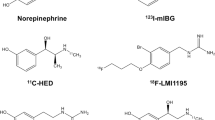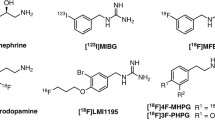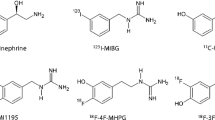Abstract
Purpose
Heart failure (HF) remains a major cause of late morbidity and mortality after myocardial infarction (MI). To date, no clinically established 18F-labeled sympathetic nerve PET tracers for monitoring myocardial infarction are available. Therefore, in this study, we synthesized a series of 18F-labeled benzyl guanidine analogs and evaluated their efficacy as cardiac neuronal norepinephrine transporter (NET) tracers for myocardial imaging. We also investigated the preliminary diagnostic capabilities of these tracers in myocardial infarction animal models, as well as the structure-activity relationship of these tracers.
Procedures
Three benzyl guanidine-NET tracers, including [18F]1, [18F]2, and [18F]3, were synthesized and evaluated in vivo as PET tracers in a myocardial infarction mouse model. [18F]LMI1195 was used as a positive control for the tracers. H&E staining of the isolated myocardial infarction heart tissue sections was performed to verify the efficacy of the selected PET tracer.
Results
Our data show that [18F]3 had a moderate decay corrected labeling yield (~10%) and high radiochemical purity (>95%) compared to other tracers. The uptake of [18F]3 in normal mouse hearts was 1.7±0.1%ID/cc at 1 h post-injection (p. i.), while it was 2.4±0.1, 2.6±0.9, and 2.1±0.4%ID/cc in the MI mouse hearts at 1, 2, and 3 days after surgery, respectively. Compared with [18F]LMI1195, [18F]3 had a better myocardial imaging effect in terms of the contrast between normal and MI hearts. The area of myocardial infarction shown by PET imaging corresponded well with the infarcted tissue demonstrated by H&E staining.
Conclusions
With an obvious cardiac uptake contrast between normal mice and the myocardial infarction mouse model, [18F]3 appears to be a potential tool in the diagnosis of myocardial infarction. Therefore, it is necessary to conduct further structural modification studies on the chemical structure of [18F]3 to improve its in vivo stability and diagnostic detection ability to achieve reliable and practical imaging effects.






Similar content being viewed by others
References
Floras JS (2021) The 2021 Carl Ludwig Lecture. Unsympathetic autonomic regulation in heart failure: patient-inspired insights. Am J Physiol Regul Integr Comp Physiol 321:R338–R351. https://doi.org/10.1152/ajpregu.00143.2021
Gupta S, Amanullah A (2015) Radionuclide imaging of cardiac sympathetic innervation in heart failure: unlocking untapped potential. Heart Fail Rev 20:215–226. https://doi.org/10.1007/s10741-014-9456-5
Snipelisky D, Chaudhry SP, Stewart GC (2019) The many faces of heart failure. Card Electrophysiol Clin 11:11–20. https://doi.org/10.1016/j.ccep.2018.11.001
Minatoguchi S (2022) Heart failure and its treatment from the perspective of sympathetic nerve activity. J Cardiol 79:691–697. https://doi.org/10.1016/j.jjcc.2021.11.016
Ramchandra R, Hood SG, Xing D, Lambert GW, May CN (2018) Mechanisms underlying the increased cardiac norepinephrine spillover in heart failure. Am J Physiol Heart Circ Physiol 1315:H340–H347. https://doi.org/10.1152/ajpheart.00069.2018
Wan N, Travin MI (2020) Cardiac imaging with 123I-meta-iodobenzylguanidine and analogous PET tracers: current status and future perspectives. Semin Nucl Med 50:331–348. https://doi.org/10.1053/j.semnuclmed.2020.03.001
Higuchi T, Yousefi BH, Kaiser F et al (2013) Assessment of the 18F-labeled PET tracer LMI1195 for imaging norepinephrine handling in rat hearts. J Nucl Med 54:1142–1146. https://doi.org/10.2967/jnumed.112.104232
Nakajima K, Scholte AJHA, Nakata T et al (2017) Cardiac sympathetic nervous system imaging with 123I-meta-iodobenzylguanidine: perspectives from Japan and Europe. J Nucl Cardiol 24:952–960. https://doi.org/10.1007/s12350-017-0818-y
Werner RA, Chen XY, Maya Y et al (2018) The impact of ageing on 11C-hydroxyephedrine uptake in the rat heart. Sci Rep 8:11120. https://doi.org/10.1038/s41598-018-29509-0
Zelt JGE, Britt D, Mair BA et al (2021) Regional distribution of fluorine-18-flubrobenguane and carbon-11-hydroxyephedrine for cardiac PET imaging of sympathetic innervation. JACC Cardiovasc Imaging 14:1425–1436. https://doi.org/10.1016/j.jcmg.2020.09.026
Alpert NM, Guehl N, Ptasze L et al (2018) Quantitative in vivo mapping of myocardial mitochondrial membrane potential. PLoS One 13:e0190968. https://doi.org/10.1371/journal.pone.0190968
Chen X, Werner RA, Koshino K et al (2022) Molecular imaging-derived biomarker of cardiac nerve integrity-introducing high NET affinity PET probe 18F-AF78. Theranostics 12:4446–4458 https://www.thno.org/v12p4446.htm
Werner RA, Chen X, Rowe SP et al (2019) Moving into the next era of PET myocardial perfusion imaging: introduction of novel 18F-labeled tracers. Int J Cardiovasc Imaging 35:569–577. https://doi.org/10.1007/s10554-018-1469-z
Zhang H, Huang R, Pillarsetty N et al (2014) Synthesis and evaluation of 18F-labeled benzylguanidine analogs for targeting the human norepinephrine transporter. Eur J Nucl Med Mol Imaging 41:322–332. https://doi.org/10.1007/s00259-013-2558-9
Turnock S, Turton DR, Martins CD et al (2020) 18F-meta-fluorobenzylguanidine (18F-mFBG) to monitor changes in norepinephrine transporter expression in response to therapeutic intervention in neuroblastoma models. Sci Rep 10:20918. https://doi.org/10.1038/s41598-020-77788-3
Yu M, Bozek J, Lamoy M et al (2011) Evaluation of LMI1195, a novel 18F-labeled cardiac neuronal PET imaging agent, in cells and animal models. Circ Cardiovasc Imaging 4:435–443. https://doi.org/10.1161/CIRCIMAGING.110.962126
Gaertner FC, Wiedemann T, Yousefi BH et al (2013) Preclinical evaluation of 18F-LMI1195 for in vivo imaging of pheochromocytoma in the MENX tumor model. J Nucl Med 54:2111–2117. https://doi.org/10.2967/jnumed.113.119966
Tay NES, Chen W, Levens A et al (2020) 19F- and 18F-arene deoxyfluorination via organic photoredox-catalysed polarity-reversed nucleophilic aromatic substitution. Nature Catalysis 3:734–742. https://doi.org/10.1038/s41929-020-0495-0
Vaidyanathan G, McDougald D, Koumarianou E et al (2015) Synthesis and evaluation of 4-[18F]fluoropropoxy-3-iodobenzylguanidine ([18F]FPOIBG): a novel 18F-labeled analogue of MIBG. Nucl Med Biol 42:673. https://doi.org/10.1016/j.nucmedbio.2015.04.005
Varasteh Z, Mohanta S, Robu S et al (2019) Molecular imaging of fibroblast activity after myocardial infarction using a 68Ga-labelled fibroblast activation protein inhibitor FAPI-04. J Nucl Med 60:1743–1749 http://jnm.snmjournals.org/content/early/2019/08/12/jnumed.119.226993
Li HT, Long CS, Rokosh DG, Honbo NY, Karliner JS (1995) Chronic hypoxia differentially regulates alpha 1-adrenergic receptor subtype mRNAs and inhibits alpha 1-adrenergic receptor-stimulated cardiac hypertrophy and signaling. Circulation 92(4):918–925. https://doi.org/10.1161/01.cir.92.4.918
Eisenhofer G, Friberg P, Rundqvist B et al (1996) Cardiac sympathetic nerve function in congestive heart failure. Circulation 93:1667–1676. https://doi.org/10.1161/01.CIR.93.9.1667
Kawai H, Mohan A, Hagen J et al (2000) Alterations in cardiac adrenergic terminal function and beta-adrenoceptor density in pacing-induced heart failure. Am J Physiol Heart Circ Physiol 278:H1708–H1716. https://doi.org/10.1152/ajpheart.2000.278.5.H1708
Shen Y, Wang Y, Li D et al (2010) Recombinant human erythropoietin pretreatment attenuates heart ischemia-reperfusion injury in rats by suppressing the systemic inflammatory response. Transplant Proc 42(5):1595–1597. https://doi.org/10.1016/j.transproceed.2009.11.050
Molitor M, Rudi WS, Garlapati V et al (2021) Nox2+ myeloid cells drive vascular inflammation and endothelial dysfunction in heart failure after myocardial infarction via angiotensin II receptor type 1. Cardiovasc Res 117(1):162–177. https://doi.org/10.1093/cvr/cvaa042
Iversen LL (1971) Role of transmitter uptake mechanisms in synaptic neurotransmission. Br J Pharmacol 41:571–591. https://doi.org/10.1021/acschemneuro.1c00575
Li X, Shi S, Zhou H, Zhao Z, Lu J (2021) Novel [18F]-labeled meta-bromobenzylguanidine derivatives: potential positron emission tomography imaging probes for the norepinephrine transporter. Mol Pharm 18:3811–3819. https://doi.org/10.1021/acs.molpharmaceut.1c00429
Yu M, Bozek J, Kagan M et al (2013) Cardiac retention of PET neuronal imaging agent LMI1195 in different species: impact of norepinephrine uptake-1 and -2 transporters. Nucl Med Biol 40:682–688. https://doi.org/10.1016/j.nucmedbio.2013.03.003
Mu L, Krämer SD, Warnock GI et al (2020) [11C]mHED PET follows a two-tissue compartment model in mouse myocardium with norepinephrine transporter (NET)-dependent uptake, while [18F]LMI1195 uptake is NET-independent. EJNMMI Res 10:114. https://doi.org/10.1186/s13550-020-00700-7
Acknowledgements
The authors would like to thank Mr. Qiang Wan (Department of Nuclear Medicine, The Affiliated Hospital of Southwest Medical University) for assistance with the cyclotron operation and the HRMS analysis of Jing Li (The Analytical Instrumentation Center of Sichuan University).
Funding
This work was funded by the National Natural Science Foundation of China (82001868), the Science and Technology Strategic Cooperation Programs of Luzhou Municipal People’s Government and Southwest Medical University (2021LZXNYD-J23). No other potential conflict of interest relevant to this article was reported.
Author information
Authors and Affiliations
Contributions
LY and LY contributed to the labeling process, image scanning, data acquisition and analysis, and manuscript writing; CW participated in the precursor synthesis; MH contributed to the animal model preparation and staining experiment. WZ and ZL contributed to the data analysis and manuscript writing; WL and YC contributed to the study design, general control of the project, and manuscript writing and revision.
Corresponding authors
Ethics declarations
Conflicts of Interest
The authors declare no competing interests.
Additional information
Publisher’s Note
Springer Nature remains neutral with regard to jurisdictional claims in published maps and institutional affiliations.
Supplementary Information
ESM 1
DOCX (3.59 MB)
Rights and permissions
Springer Nature or its licensor (e.g. a society or other partner) holds exclusive rights to this article under a publishing agreement with the author(s) or other rightsholder(s); author self-archiving of the accepted manuscript version of this article is solely governed by the terms of such publishing agreement and applicable law.
About this article
Cite this article
Yang, L., Yin, L., Hu, M. et al. Preliminary Evaluation of 18F-Labeled Benzylguanidine Analogs as NET Tracers for Myocardial Infarction Diagnosis. Mol Imaging Biol 25, 1125–1134 (2023). https://doi.org/10.1007/s11307-023-01844-3
Received:
Revised:
Accepted:
Published:
Issue Date:
DOI: https://doi.org/10.1007/s11307-023-01844-3




